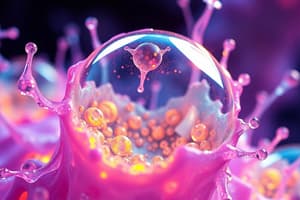Podcast
Questions and Answers
What is the primary function of the opaque disc in a darkfield microscope?
What is the primary function of the opaque disc in a darkfield microscope?
- To reflect light off the sample
- To block light that usually enters the objective lens directly (correct)
- To allow direct light to enter the objective lens
- To magnify the sample
What type of microscope is commonly used to observe live samples without fixing or staining?
What type of microscope is commonly used to observe live samples without fixing or staining?
- Fluorescence microscope
- Light microscope
- Darkfield microscope
- Phase contrast microscope (correct)
What is the purpose of fluorochrome in fluorescence microscopy?
What is the purpose of fluorochrome in fluorescence microscopy?
- To absorb UV light and emit light of longer wavelength
- To block UV light
- To treat samples with fluorescent dyes (correct)
- To detect specific antigens
What is the result of the direct and reflected light rays in a phase contrast microscope?
What is the result of the direct and reflected light rays in a phase contrast microscope?
What is the limitation of using a darkfield microscope?
What is the limitation of using a darkfield microscope?
What is the technique that uses fluorescent antibodies to detect specific antigens?
What is the technique that uses fluorescent antibodies to detect specific antigens?
What is the maximum magnification that can be achieved by a light microscope?
What is the maximum magnification that can be achieved by a light microscope?
Why were electron microscopes invented?
Why were electron microscopes invented?
What is the purpose of coating samples with heavy metals in Scanning Electron Microscopy?
What is the purpose of coating samples with heavy metals in Scanning Electron Microscopy?
What is the advantage of Scanning Electron Microscopy over Transmission Electron Microscopy?
What is the advantage of Scanning Electron Microscopy over Transmission Electron Microscopy?
What is the disadvantage of Transmission Electron Microscopy?
What is the disadvantage of Transmission Electron Microscopy?
What is the characteristic of the electron beam used in Electron Microscopy?
What is the characteristic of the electron beam used in Electron Microscopy?
Flashcards
Darkfield Microscope
Darkfield Microscope
Used to observe live, light-sensitive, or unstained samples. Blocks direct light, allowing only reflected light to enter the objective lens.
Phase Contrast Microscope
Phase Contrast Microscope
Commonly used to observe live samples. Special lenses bring out small differences in refractive indexes, images appear in shades of gray/black.
Fluorescence Microscope
Fluorescence Microscope
Uses ultraviolet light to cause fluorescence in samples, often with fluorochromes. Useful for rapid pathogen detection.
Electron Microscope
Electron Microscope
Signup and view all the flashcards
Scanning Electron Microscope (SEM)
Scanning Electron Microscope (SEM)
Signup and view all the flashcards
Transmission Electron Microscope (TEM)
Transmission Electron Microscope (TEM)
Signup and view all the flashcards
Immunofluorescence:
Immunofluorescence:
Signup and view all the flashcards
Study Notes
Darkfield Microscope
- Used to observe live, light-sensitive, or unstained samples
- Opaque disc in the condenser blocks direct light, allowing only reflected light to enter the objective lens
- Image appears bright with a dark background
- Effective for visualizing living cells that would be distorted by drying or heat, or those that can't be stained with usual methods
- Does not allow for visualization of fine internal details of cells
Phase Contrast Microscope
- Commonly used to observe live samples
- Allows detailed examination of internal structures
- Special objective lenses and ring-shaped diaphragm bring out small differences in refractive indexes of internal structures
- Images appear as various shades of gray to black due to direct and reflected light rays
Fluorescence Microscope
- Uses ultraviolet light (UV)
- Depends on samples that absorb UV light and emit light of longer wavelength
- Some organisms, like Pseudomonas, have natural fluorescence under UV light
- Other samples may be treated with fluorochrome (fluorescent dyes)
- Immunofluorescence: a technique that uses fluorescent antibodies to detect specific antigens
- Useful in rapid detection of specific pathogens
- Images appear as fluorescent objects against a dark background
Light Microscope
- Includes darkfield, phase contrast, and fluorescence microscopes
- Limitations: highest magnification of 2000X, resolving power of 0.2 um
- Viruses and most internal structures of cells cannot be seen clearly
Electron Microscope
- TWO types: Transmission Electron Microscope (TEM) and Scanning Electron Microscope (SEM)
- Developed in 1932
- Uses beams of electrons (100,000 times smaller than beams of light)
- Allows scientists to observe structures that were previously too small to be examined
Scanning Electron Microscope (SEM)
- Provides excellent views of external structures
- Magnification of 10,000X or more, resolving power of 20 nm
- Provides a 3D image of the surface of the sample
- Mechanism: samples are coated with heavy metals (gold or palladium), and a narrow beam of electron is applied to create a secondary electron beam
Transmission Electron Microscope (TEM)
- Allows scientists to observe and study internal structures of samples
- Magnification same as SEM, but resolving power of 2.5 nm or better
- Image is 2D, called electron micrograph
- Disadvantages: can only observe very thin samples, processing is tedious, and staining may be used
- Viewing of samples must be done in vacuum, and distortion of samples is often seen due to sample processing
Studying That Suits You
Use AI to generate personalized quizzes and flashcards to suit your learning preferences.




